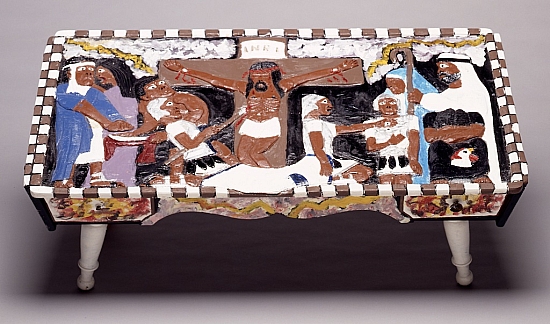Crucifixion Coffee Table
The crucifixion scene on the coffee table, as always with Singleton, is at once boldly but darkly colored. It is charged with the emotion, heightened by the turmoil of the lightning-filled clouds that stretch across the sky. In one of the rare moments when Singleton has elucidated upon a technical matter, he explains that whenever he dapples anything, it "is a sign of confusion." The stormy dappled sky above Singleton's Golgotha, then, reflects the confusion below.
The group on the left, clustered around Pontius Pilate, is unprecedented in traditional crucifixion iconography. Even though the attendant witnesses the bleeding Christ, he continues to proffer the bowl and towel, thereby becoming the perfect reflection of Pilate's vacillation and confusion. The Procurator stares intently and uncomprehendingly at Christ and proceeds to wash his hands—the quintessential act of indecision and manifest confusion. Although Matthew says that Pilate's wife sent a messenger to relay her dream, Singleton has Pilate's wife herself whisper in his ear: do not do anything "to that innocent man" (27:19), thereby making it abundantly clear that even though the truth is before him, Pilate prefers moral confusion.
Below the body of Christ is the seamless white tunic for which the two garrulous soldiers are throwing lots. While these figures are commonplace in crucifixion scenes, in the context of Singleton's work they, more than anything else, evoke the "struggle pieces." Singleton has even shown the burden that crack cocaine has become on the African American community by anachronistically depicting plantation workers stooped under bales of cotton that resemble enormous blocks of cocaine. The two soldiers could be gangsters in the midst of a drug deal, one dropping crack into the other's outstretched hand, and the seamless tunic might be nothing more than a Buffalo Bills warm-up jacket.
In contrast to the other animated figures, the group of figures on the right seems immobilized. The grieving St. Mary is conventionally depicted in a swoon of perplexity, but Singleton shows her grieving, pierced to the heart, completely absorbed and contemplative, her eyes closed like her son's. Her purpose unobscured by personal tragedy, she has robed herself in blue as the Queen of Heaven that she shall become. St. John stares straight ahead, like Pilate, but with his shepherd's staff in hand, he displays full comprehension of the event unfolding before him, and of his evangelistic mission ahead.
St. Mary and St. John are traditional elements of the crucifixion scene, but St. Peter is Singleton's own contribution. St. Peter does not display the usual crossed keys of ecclesiastical heraldry; instead, as a symbol of his confusion, his denial of Jesus while he stood before the Sanhedrin, Peter bears a disembodied cock's head on his robe. His huddled figure, with its richly expressive contour of deep despair, demonstrates Singleton's brilliant, Blake-like command of the direct symbolism of fine. As pitiful and wretched as this figure is, Singleton has invested him with the solidity of the rock Jesus had chosen him to be. Out of remorse and repentance comes great strength, and even St. John seems already to be leaning upon him.
Singleton violates decorum without knowing there is decorum to violate. Just as he arranges the neighborhood street creatures in his "struggle pieces," Singleton composes the biblical characters at the foot of the cross for his own thematic purposes: each of the figures, in their brilliantly conceived spaces, is richer for its recontextualization.
Drupal Theme and Development By: Cheeky Monkey Media
Site Design By: Constructive
